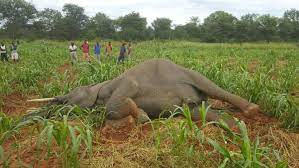
BEHIND the trail of destruction, lives and livelihoods loss is the untold story of communities living in uncertainty about what tomorrow holds for them.
The frequency and intensity of human-wildlife conflicts is increasing by the day, particularly in areas adjacent to protected areas. In some places communities have endured decades of wildlife attacks which have become part of their daily experiences.
Research confirms that human- wildlife conflict is on an increasing trajectory and becoming more difficult to manage. In most cases when the number of predators reaches a certain threshold and exceeds the national park’s carrying capacity, they spill over into the community then becomes rampant. Furthermore, climate change has also aggravated conflict as wildlife compete for scarce resources such as forage with livestock and water with both livestock and humans.
While misunderstood from a distance, for communities that live at the edge of protected areas, human-wildlife conflict is real and destructive. They experience its brunt every day.
In 2019, a Mr Ncube from Hwange was lucky to survive a tussle with a predator he was trying to snare to stop from pouncing on his goats. He was severely injured and incurred a medical bill of US$1 077.
In another sad story, an 84-year-old granny from Victoria Falls was left to fend for her three grandchildren following the gruesome and traumatic death of her daughter who had been attacked by a lion.
Mid last year, Chipinge ward 20 residents were left distraught four people killed by wild animals which destroyed tonnes of ready-to-harvest crop.
Elsewhere in Masvingo, in Bota village, a cackle of hyenas attacked a couple and their son leaving them badly injured after they tried to prevent them from attacking their cattle.
- Mavhunga puts DeMbare into Chibuku quarterfinals
- Bulls to charge into Zimbabwe gold stocks
- Ndiraya concerned as goals dry up
- Letters: How solar power is transforming African farms
Keep Reading
On December 19, 2023 there we reports of a “problem” elephant which destroyed houses in Kariba Breezes compound. In wildlife conservation context, a problem animal is a specific one with a history of attacking humans, causing damage or creating the potential to cause damage to public health and safety, infrastructure or private property. In this case the elephant smashed roofs of two houses, before destroy a brick wall at a third house. Though no injury or death was recorded, such destruction is usually unforeseen and burdens families which need to repair the broken down properties.
Drivers of human-wildlife conflict
Interactions between wildlife and people are essentially a function of physical encounters which occur when there is some kind of spatiotemporal overlap in space manifesting in shared land or resources such as crops, water or stored food.
Human population growth is one of the most significant factors exacerbating human-wildlife conflict globally. Co-existence between humans and wildlife was in the past more attainable until people started cultivating land for agricultural purposes and tamed animals. A rise in human population, the subsequent demand for settlements and socio-economic livelihoods has led to expansion of human activities which are encroaching on conservation and wildlife areas.
Anthropogenic land use transformations at the edge of protected areas have triggered conflict “hot spots”. The proliferation of huge commercial farms in the early 2000s along the Zambezi River front transformed formerly wildlife habitat diverting traditional wildlife dispersal routes, thus increasing conflict.
Human–wildlife conflicts are triggered by the competition for resources (food, water, forage and land) between wildlife and humans or livestock. This tension is particularly acute in agricultural landscapes, where natural lands have been modified to maximise the production of agricultural commodities or other ecosystem services to support livelihoods.
Encroachment into wildlife space by settlement expansion has transformed forests, savannah and other ecosystems into urban agglomerates. In Zimbabwe land apportionment pushed people into risky areas and some households are settled right in the heart of wildlife corridors, exposing households’ crops, property and livestock to destruction by such animals as elephants.
Not only does subsistence poaching destroy wildlife habitat, it evidently disturbs natural food chains and food webs in the ecosystem. The use of a fire in subsistence poaching in the Zambezi Valley leads to the unselective destruction of the wildlife habitat and food sources.
When smaller animals are poached, they interrupt the food chain or food web of carnivores such as leopards, hyenas, painted dogs, lions and cheetahs. The decimation of their prey from the wildlife population through poaching will imply that the predators will be left with no alternative food sources, except domestic livestock such as goats, sheep, donkeys and cattle, hence human-wildlife conflict.
Recommendations
Understanding the socio-economic background of a community is key in advancing human-wildlife coexistence. Contextually understanding the values, social norms, beliefs, culture, economics and interactions between stakeholders and other social and political factors is key for planning and implementing any human-wildlife conflict mitigation initiative.
Conservation without community is doomed, thus the need for collaborative design of conflict mitigation and damage reduction interventions. Genuine collaboration can allow a balance of diverse goals, negotiation of acceptable trade-offs and allow communities to adjust their expectations about levels of impact or develop skills required to adapt to new situations in the future.
Lastly, long-term solutions need to incorporate landscape-scale ecological, economic and physical patterns. Properly planned land use will act as a catalyst in the process of achieving sustainable human-wildlife coexistence. Participation is key. It is crucial for communities living near wildlife to be actively engaged in ideas and decisions on how to effectively minimise human-wildlife conflict.
Farai Madende Nhekairo is a researcher, writer, socio-ecologist and development practitioner. She is the Founder of Community Impact Solutions, ClimSmartSOL and CEO EatOut Movement.








